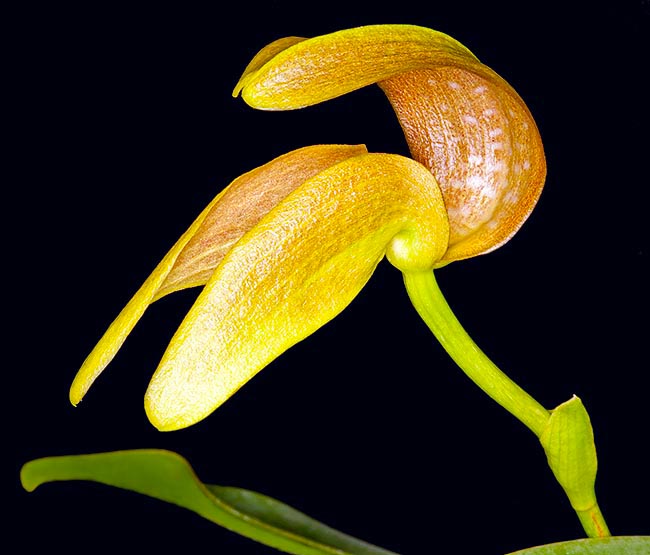Family : Orchidaceae

Text © Pietro Puccio

English translation by Mario Beltramini

The huge solitary flowers of Bulbophyllum grandiflorum have an odd, much appreciated, shape © G. Mazza
The name of the genus is the combination of the Greek terms “bulbos” = bulb and “phyllon” = leaf, with reference to the leaves growing at the apex of the pseudobulbs; the name of the species is the combination of the Latin terms “grandis” = big and “flos, -oris” = flower, with obvious reference.
The Bulbophyllum grandiflorum Blume (1849) is an epiphytic species with ovoid pseudobulbs, spaced of 2-3 cm on a creeping rhizome, 3-5 cm long, carrying at the apex a single ovate leaf, coriaceous, 12-15 cm long and 4-5 cm broad.
Solirtary flowers, of colour going from the greenish yellow to the pale bronze, 10-15 cm large, from the base of the pseudobulb on an erect or arcuate peduncle, with 2-4 tubular bracts, up to 25 cm long. The sepals are the part more apparent of the flower; the upper sepal is ovate-elliptic, 7-8 cm long, bent forward with lateral retroflexed margins and several semi-transparent whitish dots, the lateral ones are oblong, twisted, 6-10 cm long. The petals, which are triangular, are so small to be almost invisible; the tiny trilobed labellum is mobile and oscillates at the least breath of wind.
The flowers, that emit a scent many consider as unpleasant, last 2-3 weeks. It reproduces by seed, in vitro, and by division, with each section provided with at least 3-4 pseudobulbs.
Floriferous species, appreciated by the collectors for the quite particular shape of the flowers, it requires medium-high temperatures with night low temperatures not inferior to 15-16 °C, high luminosity and atmospheric humidity, 60-80%, frequent waterings, but allowing the roots to dry up; it does not have a definite resting period, but it is preferable to slightly decrease the frequency in winter.
For the waterings and the nebulisations, it is to be utilized rain water, or water obtained through reverse osmosis, or demineralised; the fertilizations, duly distributed in function to the vegetative status of the plant and alternated, in way to avoid salts accumulations at the roots, are to be done preferably with hydrosoluble balanced products, with microelements, at ¼ of the dosage suggested on the package.
It is t be mounted on bark, trunks, cork or arborescent ferns roots rafts, or placed in baskets with a much draining and aerated compost, this may be formed by medium-sliced bark fragments.
The species is reported in the appendix II of the CITES (species whose trade is internationally ruled).
Synonyms: Ephippium grandiflorum Blume (1849); Phyllorchis grandiflora (Griff.) Kuntze (1891); Phyllorkis grandiflora (Blume) Kuntze (1891); Sarcopodium grandiflorum (Blume) Lindl. (1853); Bulbophyllum cominsii Rolfe (1898); Bulbophyllum burfordiense Hook.f. (1901); Hyalosema cominsii (Rolfe) Rolfe (1919); Hyalosema grandiflorum (Blume) Rolfe (1919).
→ For general notions about ORCHIDACEAE please click here.
